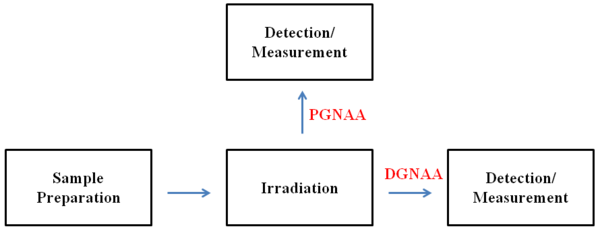| << Chapter < Page | Chapter >> Page > |
The final parameter to be discussed is the time of measurement. The nuclear decay products can be measured either during or after neutron irradiation. If the gamma rays are measured during irradiation, the procedure is known as prompt gamma neutron activation analysis (PGNAA). This is a special type of NAA that requires additional equipment including an adjacent gamma detector and a neutron beam guide. PGNAA is often used for elements with rapid decay rates, elements with weak gamma emission intensities, and elements that cannot easily be determined by delayed gamma neutron activation analysis (DGNAA) such as hydrogen, boron, and carbon. In DGNAA, the emitted gamma rays are measured after irradiation. DGNAA procedures include much longer irradiation and decay periods than PGNAA, often extending into days or weeks. This means that DGNAA is ideal for long-lasting radioactive isotopes. A schematic comparison of PGNAA and DGNAA is shown below in [link] .

Throughout recent decades, NAA has often been used to characterize many different types of samples including archaeological materials. In 1961, the Demokritos nuclear reactor, a water moderated and cooled reactor, went critical at low power at the National Center for Scientific Research “Demokritos” (NCSR “Demokritos”) in Athens, Greece. Since then, NCSR “Demokritos” has been a leading center for the analysis of archaeological materials.
Ceramics, carbonates, silicates, and steatite are routinely analyzed at NCSR “Demokritos” with NAA. A routine analysis begins by weighing and placing 130 milligrams of the powdered sample into a polyethylene vial. Two batches of ten vials, eight samples and two standards, are then irradiated in the Demokritos nuclear reactor for 45 minutes at a thermal neutron flux of 6 x 10 13 neutrons cm -2 s -1 . The first measurement occurs seven days after irradiation. The gamma ray emissions of both the samples and standards are counted with a germanium gamma detector (semiconductor type) for one hour. This measurement determines the concentrations of the following elements: As, Ca, K, La, Lu, Na, Sb, Sm, U, and Yb. A second measurement is performed three weeks after irradiation in which the samples and standards are counted for two hours. In this measurement, the concentrations of the following elements are determined: Ba, Ce, Co, Cr, Cs, Eu, Fe, Hf, Nd, Ni, Rb, Sc, Ta, Tb, Th, Zn, and Zr.
Using the method described above, NCSR “Demokritos” analyzed 195 samples of black-on-red painted pottery from the late Neolithic age in what is now known as the Black-On-Red Pottery Project. An example of black-on-red painted pottery is presented in [link] .


Notification Switch
Would you like to follow the 'Physical methods in chemistry and nano science' conversation and receive update notifications?